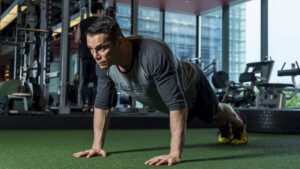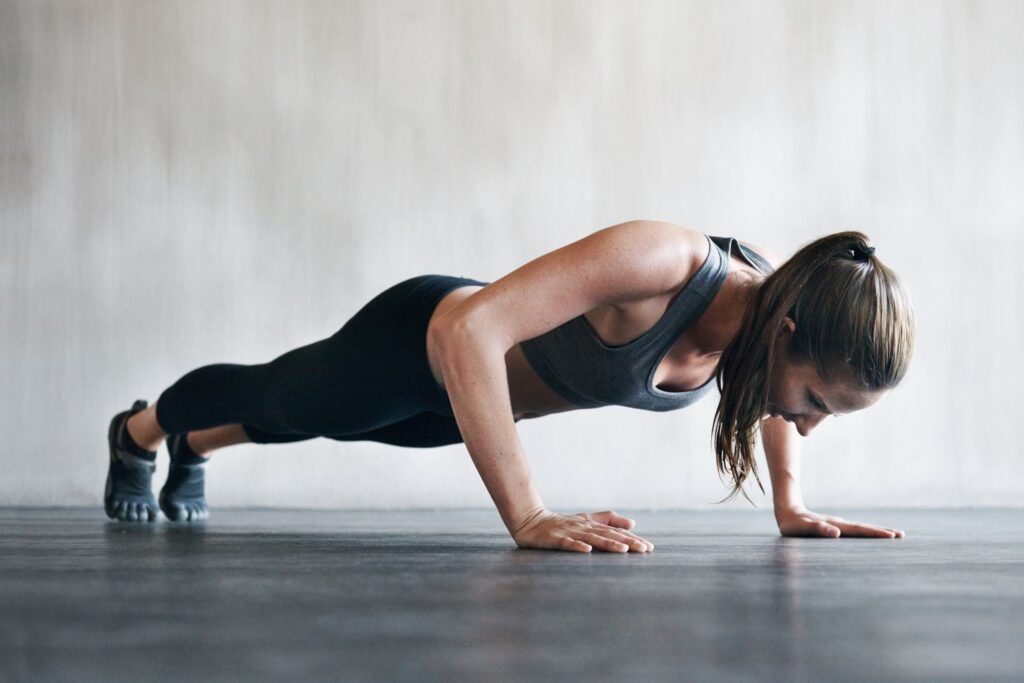Pushups. They might conjure up images of gym class struggles or childhood fitness tests. But take this seemingly basic exercise seriously. Pushups are a powerhouse move that deserves a prominent place in any fitness routine.
This blog post dives deep into the world of pushups, exploring the benefits they offer, proper form to maximize results, variations to target different muscle groups, and tips to overcome challenges. Whether you’re a seasoned athlete or a fitness beginner, there’s valuable information here to help you unlock the full potential of pushups.
The Benefits of Pushups: More Than Just Upper Body Strength
Pushups aren’t just about sculpted arms and a chiseled chest. Here’s a glimpse into the diverse benefits they offer:
- Builds Upper Body Strength: The primary benefit of pushups lies in strengthening your upper body. They target your chest muscles (pectorals), triceps, shoulders (deltoids), and biceps.
- Engages Your Core: It aren’t an isolated upper body exercise. Maintaining a proper plank position throughout the movement requires core engagement, strengthening your abdominal muscles, and improving overall stability.
- Improves Bone Density: It are a weight-bearing exercise, meaning they force your body to work against gravity. This helps increase bone density, reducing the risk of osteoporosis later in life.
- Enhances Overall Fitness: The compound nature of pushups, engaging multiple muscle groups, contributes to improved overall fitness. They elevate your heart rate, improve cardiovascular health, and boost functional strength.
- Boosts Confidence: Mastering pushups can be a significant accomplishment. Witnessing your strength and improvement can translate into increased confidence in all aspects of life.
- Requires No Equipment: It are a bodyweight exercise, making them incredibly accessible. You can perform them anywhere, anytime, with no equipment needed.
Mastering the Form: The Key to Effective Pushups
Proper form is crucial to maximize the benefits of pushups and avoid injuries. Here’s a step-by-step guide to performing a perfect pushup:
- Start in a high plank position: Place your hands flat on the floor, shoulder-width apart, fingers pointing forward. Keep your body in a straight line from head to heels, core engaged, and glutes squeezed.
- Lower Yourself: Bend your elbows and slowly lower your chest towards the ground. Keep your elbows tucked in close to your body, not flared out. Imagine scraping your chest against the floor as you descend.
- Maintain a Straight Line: Throughout the movement, ensure your body forms a straight line from head to heels. Don’t let your hips sag or arch your back.
- Push Back Up Once your chest nearly touches the ground, engage your core and triceps to push yourself back up to the starting position. Maintain a steady and controlled movement.

Variations for Different Levels and Targets:
Pushups cater to various fitness levels by offering modifications and variations. Here are a few examples:
- Beginner Pushups: If performing a full pushup is initially difficult, start with knee pushups. Perform the same form as a standard pushup, but with your knees on the ground for support.
- Incline Pushups: Elevate your hands on a sturdy bench or chair to make the movement less challenging. This variation is a great starting point for beginners.
- Decline Pushups: Performed with your feet elevated on a platform, decline pushups increase the difficulty of the exercise, targeting the lower chest muscles more intensely.
- Diamond Pushups: Bring your hands closer together, forming a diamond shape with your thumbs and index fingers touching. This variation places greater emphasis on your triceps.
- Wide Pushups: Increase the hand placement beyond shoulder width. This variation engages your chest muscles more deeply.
Conquering the Challenge: Tips for Overcoming Pushup Struggles
Keep going even if you can’t perform multiple perfect pushups initially. Here are some tips to help you progress:
- Start Slow and Build Gradually: Begin with a manageable number of repetitions and sets within your current capability. Gradually increase the number of repetitions or sets as your strength improves.
- Focus on Form Over Reps: Prioritizing proper form over completing many repetitions with bad form will prevent injuries and maximize results.
- Incorporate Negatives: Negative pushups can be helpful for beginners. Start in the high plank position, then slowly lower yourself down with control. You can use a step or platform to push yourself back up initially.
- Incorporate Pushups into Your Routine: Regular practice is key to improvement. Aim to include pushups in your workout routine at least 2-3 times per week, with rest days in between to allow your muscles to recover.
- Listen to Your Body: Don’t push yourself to the point of pain. If you experience any discomfort, stop the exercise and consult a healthcare professional if necessary.
- Mix it Up: While standard pushups are excellent, incorporate variations from time to time to target different muscle groups and prevent plateaus in your progress.
- Track Your Progress: Keeping track of the number of repetitions or sets you can complete can be a great motivator. Witnessing your improvement can fuel your dedication.
- Consider Additional Exercises: Pushups are fantastic, but consider incorporating other exercises that target different muscle groups for a well-rounded fitness routine. Exercises like rows, planks, and lunges can complement your pushup training.

Pushups: A Lifelong Fitness Companion
It are a timeless exercise that offers a wealth of benefits. Whether you’re a seasoned athlete looking to enhance your upper body strength or a beginner seeking a convenient and effective way to improve overall fitness, pushups are an excellent addition to your routine.
Remember, consistency and proper form are key to unlocking the full potential of pushups. Start slow, prioritize form over quantity, and celebrate your progress. With dedication and practice, you’ll be amazed at the strength and confidence you can build through the power of pushups.
Bonus: Pushup Challenge:
Feeling inspired? Why not try a pushup challenge? Here’s a sample challenge you can adapt to your current fitness level:
- Week 1: Start with 3 sets of 5-8 repetitions, with rest days in between sets and workouts.
- Week 2: Increase to 3 sets of 8-10 repetitions.
- Week 3: Aim for 3 sets of 10-12 repetitions.
- Week 4: Challenge yourself with 3 sets of 12-15 repetitions, or incorporate pushup variations into your sets.
Remember, this is just a sample. Adjust the repetitions and sets based on your capabilities and gradually increase the difficulty as you get stronger.
So, what are you waiting for? Get down on the floor and experience the power of pushups!
